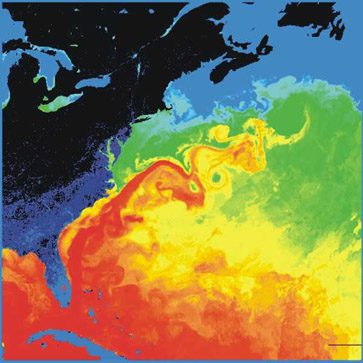A recent study indicates the potential for a catastrophic collapse of the Atlantic Meridional Overturning Circulation (AMOC), a vital ocean current system, as early as 2025 due to global warming. Researchers have identified alarming signs of a tipping point in the AMOC, which is currently at its weakest state in over 1,600 years. If global carbon emissions continue to rise unchecked, the estimated collapse could occur between 2025 and 2095, with a central estimate of 2050. Past incidents of AMOC collapses, during ice ages, resulted in dramatic temperature changes of up to 10C within a few decades. Global heating has introduced a surge of fresh water from rapidly melting ice caps, particularly in Greenland, which is smothering the AMOC currents.
The collapse of AMOC would trigger catastrophic climate impacts worldwide, disrupting the rainfall patterns vital for food production in India, South America, and west Africa. Europe could experience an increase in storms and a drop in temperatures, while the eastern coast of North America could see a rise in sea levels. Ecosystems such as the Amazon rainforest and Antarctic ice sheets would face further threats due to the potential AMOC shutdown. There has been no recorded shutdown of the AMOC for over 12,000 years, making a possible future collapse a significant climate concern.
“Shutting down the AMOC can have very serious consequences for Earth’s climate, for example, by changing how heat and precipitation are distributed globally. While a cooling of Europe may seem less severe as the globe as a whole becomes warmer and heat waves occur more frequently, this shutdown will contribute to an increased warming of the tropics, where rising temperatures have already given rise to challenging living conditions.”
– Professor Peter Ditlevsen from the Niels Bohr Institute.
This potential collapse joins other climate tipping points that scientists are increasingly worried about as global temperatures rise. Research in 2022 suggested that five dangerous tipping points, including the shutdown of AMOC and the collapse of Greenland’s ice cap, may have already been passed due to the 1.1C global heating observed to date. This recent study from the University of Copenhagen, featured in Nature Communications, evaluated sea surface temperatures dating back to 1870. This data was linked to patterns seen in systems nearing a ‘saddle-node bifurcation’ tipping point.
The study’s predictions are based on current greenhouse gas emission rates, but if emissions begin to fall as per climate policies, the tipping point could be postponed. The Intergovernmental Panel on Climate Change’s recent assessment concluded that an AMOC collapse this century was unlikely, a finding that contrasts with this new study. Researchers contest that IPCC’s models could be too conservative, as they lack the resolution and proficiency to assess non-linear processes accurately.
“Using new and improved statistical tools, we’ve made calculations that provide a more robust estimate of when a collapse of the Thermohaline Circulation is most likely to occur, something we had not been able to do before”
- Professor Susanne Ditlevsen of UCPH’s Department of Mathematical Sciences.
The potential AMOC collapse remains a controversial topic among scientists, who unanimously agree that it should be avoided “at all costs”. Prof Niklas Boers, who revealed early warning signs of the AMOC collapse in 2021, emphasizes the uncertainties in the new study’s simplified model and the underlying sea temperature data. Dr. Levke Caesar points to the use of sea surface temperatures as proxy data for the strength of AMOC currents as a key source of uncertainty, as direct observational data only exists since 2004.
Prof Tim Lenton of the University of Exeter posits that even a partial AMOC collapse, such as in the Labrador Sea, would still have major impacts. There is a growing consensus that the AMOC is in peril, backed by data from a network of ocean buoys since 2004 and other “proxy” indicators showing a weakening of the system over the past 1,000 years. Researchers used records of sea surface temperatures dating back to 1870 and identified increasingly large fluctuations and slow recoveries to normalcy as early warning signals of AMOC instability. The consequences of a total AMOC shutdown wouldn’t match the apocalyptic scenario in the film “The Day After Tomorrow”, but could entail drastic climatic shifts including cooling in northern Europe and intensified warming in the tropics.
The study doesn’t provide new observations of the entire ocean system but extrapolates future scenarios based on past data from a limited region of the Atlantic, prompting caution in interpreting the findings. There is a collective call from the scientific community for further research on AMOC instability, given the dire consequences of even a partial shutdown. Uncertainty remains regarding the exact location of the AMOC tipping point, but the new study suggests it may be closer than previously thought. The accumulating scientific evidence indicates that the risk of crossing the AMOC tipping point within the next couple of decades cannot be ruled out, calling for urgent actions to mitigate greenhouse gas emissions.


















